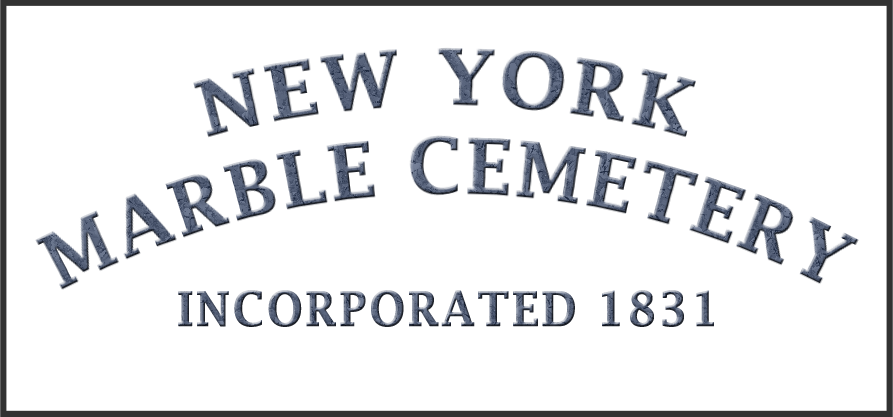A Chronology Of
New York Marble Cemetery
1820
Commerce with the Caribbean has long made East Coast ports susceptible to outbreaks of tropical illness. The yellow fever epidemic of 1822, which originates near the Trinity churchyard, spurs the Common Council to ban burials below Canal and Grand Streets. The city fathers hope that this will help curb the spread of disease. The Council later extends the prohibited area to include the area up to 14th Street, but allows burials in private family vaults.
1830
In July, Anthony Dey and George W. Strong, as organizing trustees, purchase the land for the New York Marble Cemetery. A layout drawn the same day, probably by developer Perkins Nichols, indicates the names of those already committed to buying almost all of the $250 vaults.
1831
The state Senate and Assembly pass the Act of Incorporation for the Cemetery.
The nearby New York City Marble Cemetery purchases its land on Second Street. The developer is again Perkins Nichols.
1833
An Index Stone on the West Wall listing all owners, a stone on the East Wall engraved with the names of the developer and the original trustees, and stone coping on top of the walls are all added. The grounds are to be “soiled and ornamented.”
1851
Traditional earthen burials are banned below 86th Street. Other cemeteries start removing remains to the recently-established “rural” cemeteries in Brooklyn and Queens; their churches then sell their Manhattan burial grounds.
1854
“A substantial iron gate” is erected on the street, fencing between the inner and outer gates is repaired, and the passageway is flagged.
1880’s
Population pressures increase, with both Second Avenue north of Houston Street and the nearby Lower East Side becoming destinations for large numbers of immigrants from Central and Eastern Europe. There is much uncertainty about the future of both Marble Cemeteries, with the possibility that the City will take their lands for public uses, such as schools.
1897
Social reformer Jacob Riis tries to have the New York Marble Cemetery turned into a playground. The owners must all agree and cannot be found.
1905 – 1906
A failed attempt to dissolve the Cemetery and sell its land leads to a complete reorganization, spearheaded by J. Frederick Kernochan, Edward J. Parish, and Daniel Parish. William Newcomb produces a large subscription list and the ensuing fundraising appeal creates an endowment of $21,000. The original owners have all died, but the families of many of them contribute generously. A few families, seeing an uncertain future, empty their vaults.
The walls are completely repointed.
1907 – 1908
The outer gates are moved to the inside of the alley to replace the old wooden ones. New cast iron gates by William R. Pitt are erected on Second Avenue.
1927
New fundraising is announced, but it never gets off the ground.
1937
A public relations drive to find heirs to the vaults is abandoned because too many generations have elapsed since the Cemetery’s founding.
The most recent burial takes place, in the VanZandt vault.
1956
The Dead House in the southwest corner is demolished.
1969
The Cemetery is designated a New York City Landmark.
1974
All 19th-century legal, financial, and administrative records, registers, and minute books are deposited for safekeeping at the New-York Historical Society.
1980
The Cemetery is placed on the National Register of Historic Places.
The north wall, long undermined by the below-grade areaway along Third Street, has buckled and begins to crumble. Freezing moisture continues to force many of the marble owners’ tablets from the walls.
The neighborhood is at a low point.
1998
Robert Silman Associates performs a survey of conditions and rehabilitation costs for the above-ground walls.
Research begins to identify burials, owners of record, and living descendants, whom the Trustees contact. Renewal of the grounds begins.
2000 – (Present Time)
Much of the Cemetery’s 1906 endowment is used for emergency stabilization. Both pairs of gates are restored. A major fundraising drive is organized. Two sections of the East Wall collapse and are rebuilt.
The Cemetery becomes accessible to the public through a website, published burial records, the resumption of May owners’ meetings, scheduled openings, an annual newsletter, and grounds rental for private gatherings.
